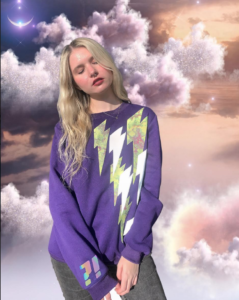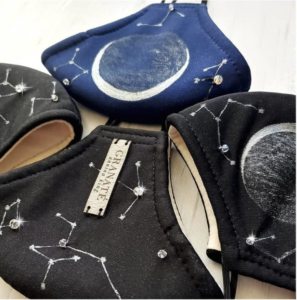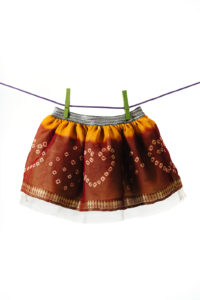In 2020, comfort was key.
Elissa Bloom, executive director of the Philadelphia Fashion Incubator, saw the popularity of items like sweatpants, sneakers and leggings skyrocket throughout the fashion world. Those fortunate enough to work from home started taking business calls in sweatsuits instead of pantsuits and attended conferences in dress shirts over pajama bottoms.
Even as business casual outfits hang abandoned in closets, Bloom, who is Jewish, said local designers elevated the humble sweatshirt to a stylish wardrobe staple without sacrificing comfort.
“I know that a lot of different designers have been manipulating the sweatshirts or putting an applique or painting or doing embroidery,” she said.
Danielle Tobin, founder of the apparel and accessories brand Elle Tobin, has embraced what she describes as the “COVID cozy” trend and designed several brightly colored sweatshirts from sustainable materials and reflective fabric that glows in the dark.

“It was most inspired by comfort first, and the second thing I was inspired by was just being bright and bold. Things were dark, and there was a lot of uncertainty, and I really just wanted to bring some sunshine to people’s faces,” she said.
Galit Carmely, owner of the boutique My Little Redemption in Old City, said the emphasis on comfort and bright colors combined with another trend: the return of the ’80s. Shoulder pads and oversized sneakers were already creeping back into closets before the pandemic hit, but the necessity of working from home combined with a desire for bright visuals has accelerated the popularity of loose fits and colorful prints.
Carmely prefers the oversized sweatsuit trend to leggings, which she thinks are clingy and unflattering. She gravitates more toward classic and timeless pieces in her own wardrobe and inventory, but embraced the emphasis on comfort and some of the subtler aesthetic trends of 2020.
“I’m going toward the colorful pieces, a lot of matching,” said Carmely, who is Israeli. “Pieces like a jacket that’s not very fitted, that’s more loose and comfortable, but has some shape to it. And I’m all about the same color for the top and the bottom.”
She expects high-waisted pants and more bright prints will be popular this summer. Much like last year, comfort will dictate outfit preferences; think fewer dresses and more jumpsuits.
Bloom said eye-catching accessories have become popular due to the ubiquity of Zoom meetings.
“Statement earrings and necklaces have been making a comeback because people are only visible from the chest up on Zoom calls,” she explained. “I’ve seen a lot of really interesting, more chunky, kind of bold types of necklaces and earrings.”
She added that Incubator designers have also embraced face masks, which are literally the must-have accessory of the pandemic since you won’t be allowed in the grocery store without one. Tobin has created several using reflective fabric, and Annina King, owner of Granaté Prêt, created a line of masks embellished with Swarovski crystals and hand-painted by local artists.

Photo by Annina King
“Who would have thought, a year ago, that masks would be our fashion accessory of the year? That we’d be finding one to match every outfit or match our winter scarf?” she said.
King also started an initiative to hire local workers to sew masks for hospitals that needed them in the early days of the pandemic. She is now working on a line of masks that will minimize acne for wearers and consulting dermatologists to find the best materials.
Bloom said the supply chain issues and economic upheaval created by the pandemic accelerated a trend of upcycling and sustainability that has built over the past few years. Rather than shopping for new clothes, people are more likely to spend carefully, alter or tailor items they already own or embrace do-it-yourself projects like tie-dye.
Namita Penugonda Reddy, founder of Samsara Sari, repurposes old saris into dresses, skirts, scrunchies and other items. Samsara, which means “rebirth” in Sanskrit, refers to the process of giving new life to used garments. During the pandemic, she has focused on making tutu skirts for young girls.

Courtesy of Namita Penugonda Reddy
“Even if they aren’t going anywhere, people still want their kids to look cute,” she said.
Bloom said the recession has led to a surge of interest in shopping locally, fueled by an awareness that struggling small businesses might not make it through the pandemic without shoppers’ support. Rather than ordering from fast fashion retail giants like H&M, people are thinking strategically about preserving businesses that contribute to their local economy and communities.
“People are really being more discerning and thinking, ‘What is important to me? What are the essentials that I really need in my wardrobe?’” she said.



